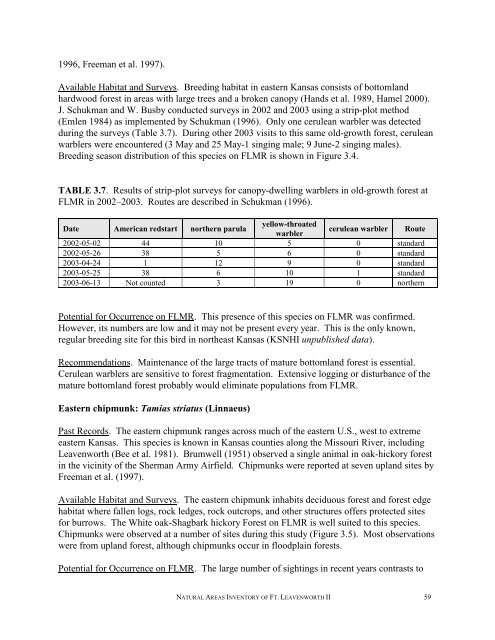A Natural Areas Inventory of the - Kansas Natural Heritage Inventory ...
A Natural Areas Inventory of the - Kansas Natural Heritage Inventory ...
A Natural Areas Inventory of the - Kansas Natural Heritage Inventory ...
You also want an ePaper? Increase the reach of your titles
YUMPU automatically turns print PDFs into web optimized ePapers that Google loves.
1996, Freeman et al. 1997).<br />
Available Habitat and Surveys. Breeding habitat in eastern <strong>Kansas</strong> consists <strong>of</strong> bottomland<br />
hardwood forest in areas with large trees and a broken canopy (Hands et al. 1989, Hamel 2000).<br />
J. Schukman and W. Busby conducted surveys in 2002 and 2003 using a strip-plot method<br />
(Emlen 1984) as implemented by Schukman (1996). Only one cerulean warbler was detected<br />
during <strong>the</strong> surveys (Table 3.7). During o<strong>the</strong>r 2003 visits to this same old-growth forest, cerulean<br />
warblers were encountered (3 May and 25 May-1 singing male; 9 June-2 singing males).<br />
Breeding season distribution <strong>of</strong> this species on FLMR is shown in Figure 3.4.<br />
TABLE 3.7. Results <strong>of</strong> strip-plot surveys for canopy-dwelling warblers in old-growth forest at<br />
FLMR in 2002–2003. Routes are described in Schukman (1996).<br />
Date American redstart nor<strong>the</strong>rn parula<br />
yellow-throated<br />
warbler<br />
cerulean warbler Route<br />
2002-05-02 44 10 5 0 standard<br />
2002-05-26 38 5 6 0 standard<br />
2003-04-24 1 12 9 0 standard<br />
2003-05-25 38 6 10 1 standard<br />
2003-06-13 Not counted 3 19 0 nor<strong>the</strong>rn<br />
Potential for Occurrence on FLMR. This presence <strong>of</strong> this species on FLMR was confirmed.<br />
However, its numbers are low and it may not be present every year. This is <strong>the</strong> only known,<br />
regular breeding site for this bird in nor<strong>the</strong>ast <strong>Kansas</strong> (KSNHI unpublished data).<br />
Recommendations. Maintenance <strong>of</strong> <strong>the</strong> large tracts <strong>of</strong> mature bottomland forest is essential.<br />
Cerulean warblers are sensitive to forest fragmentation. Extensive logging or disturbance <strong>of</strong> <strong>the</strong><br />
mature bottomland forest probably would eliminate populations from FLMR.<br />
Eastern chipmunk: Tamias striatus (Linnaeus)<br />
Past Records. The eastern chipmunk ranges across much <strong>of</strong> <strong>the</strong> eastern U.S., west to extreme<br />
eastern <strong>Kansas</strong>. This species is known in <strong>Kansas</strong> counties along <strong>the</strong> Missouri River, including<br />
Leavenworth (Bee et al. 1981). Brumwell (1951) observed a single animal in oak-hickory forest<br />
in <strong>the</strong> vicinity <strong>of</strong> <strong>the</strong> Sherman Army Airfield. Chipmunks were reported at seven upland sites by<br />
Freeman et al. (1997).<br />
Available Habitat and Surveys. The eastern chipmunk inhabits deciduous forest and forest edge<br />
habitat where fallen logs, rock ledges, rock outcrops, and o<strong>the</strong>r structures <strong>of</strong>fers protected sites<br />
for burrows. The White oak-Shagbark hickory Forest on FLMR is well suited to this species.<br />
Chipmunks were observed at a number <strong>of</strong> sites during this study (Figure 3.5). Most observations<br />
were from upland forest, although chipmunks occur in floodplain forests.<br />
Potential for Occurrence on FLMR. The large number <strong>of</strong> sightings in recent years contrasts to<br />
NATURAL AREAS INVENTORY OF FT. LEAVENWORTH II 59


